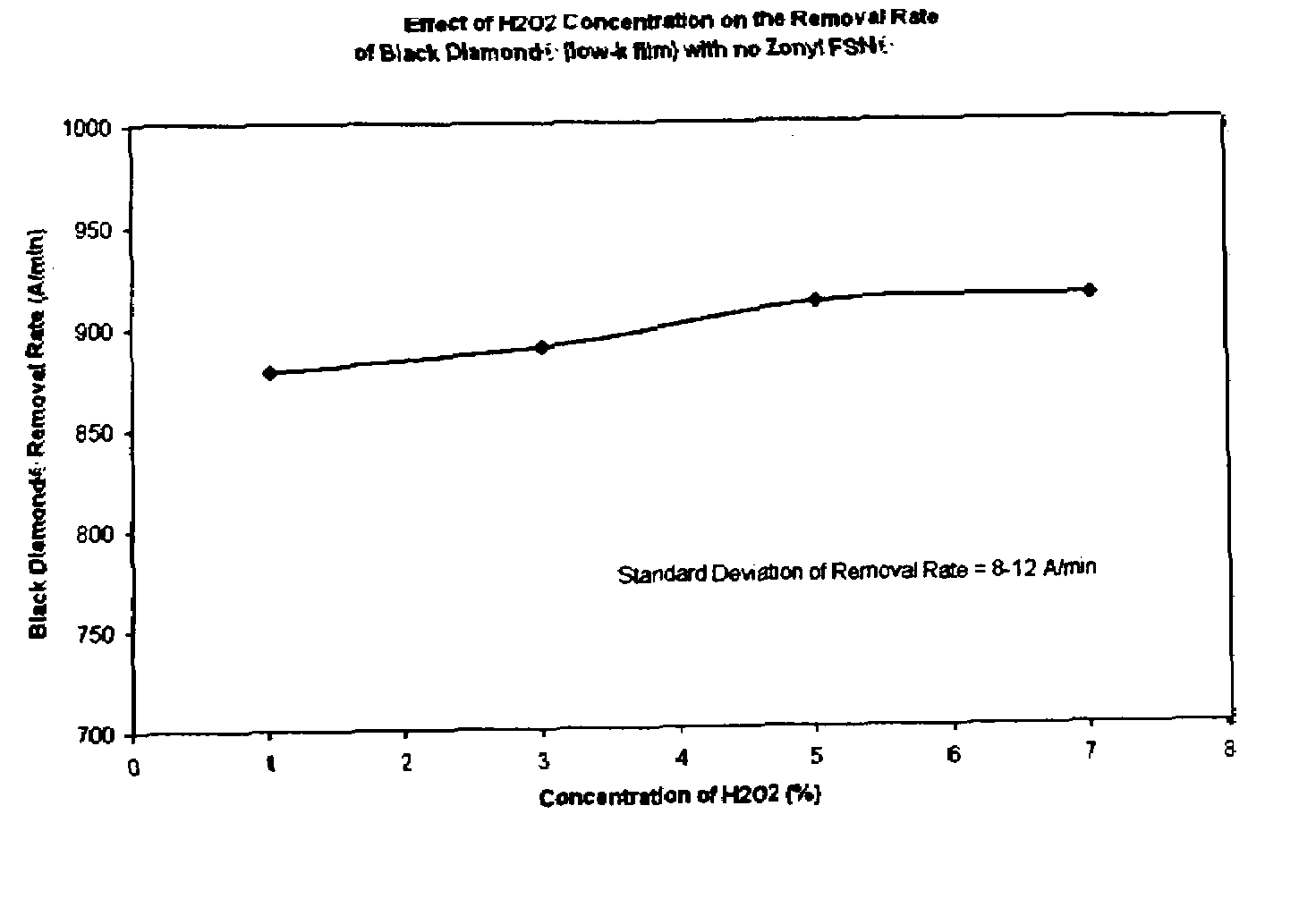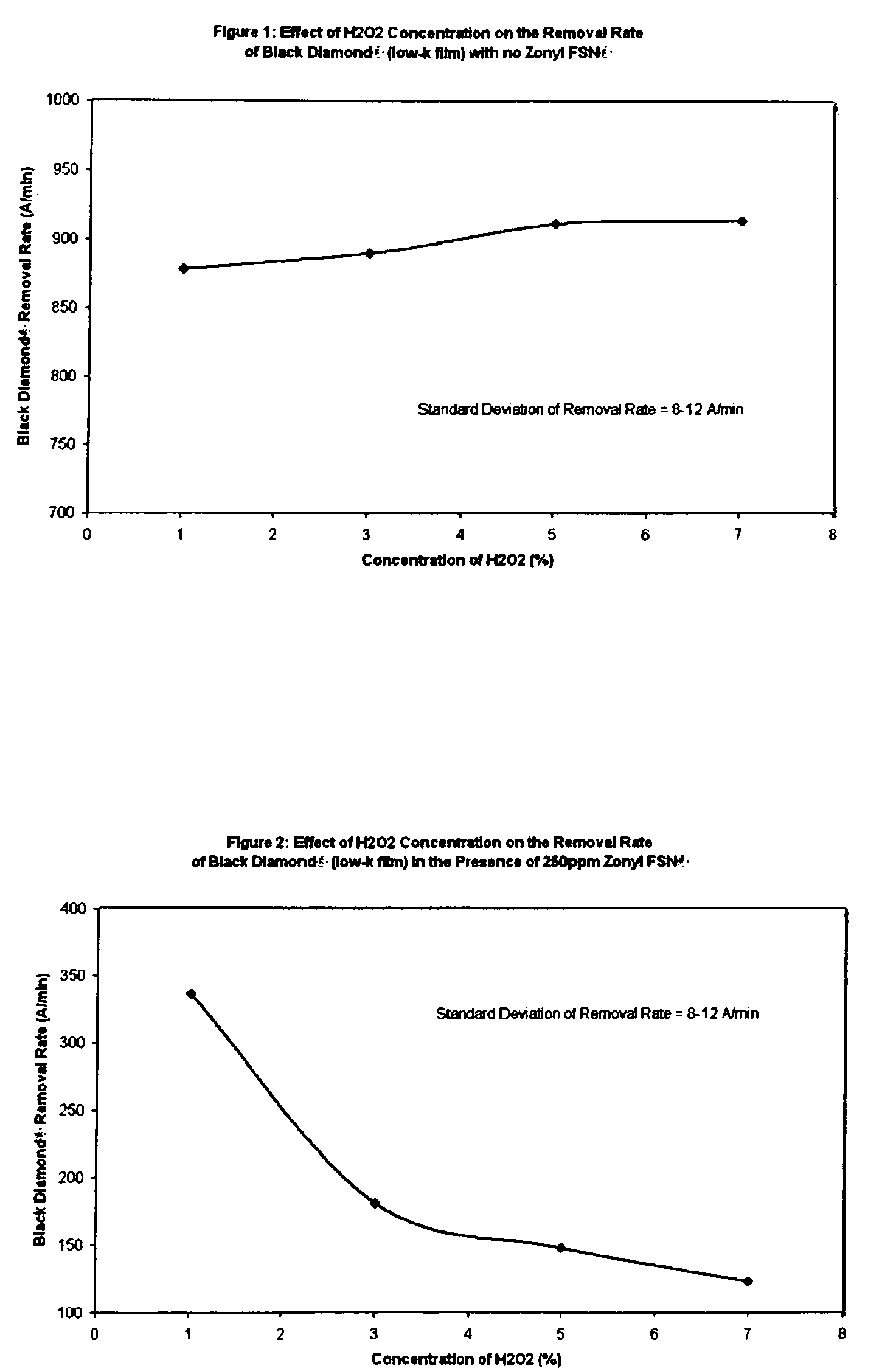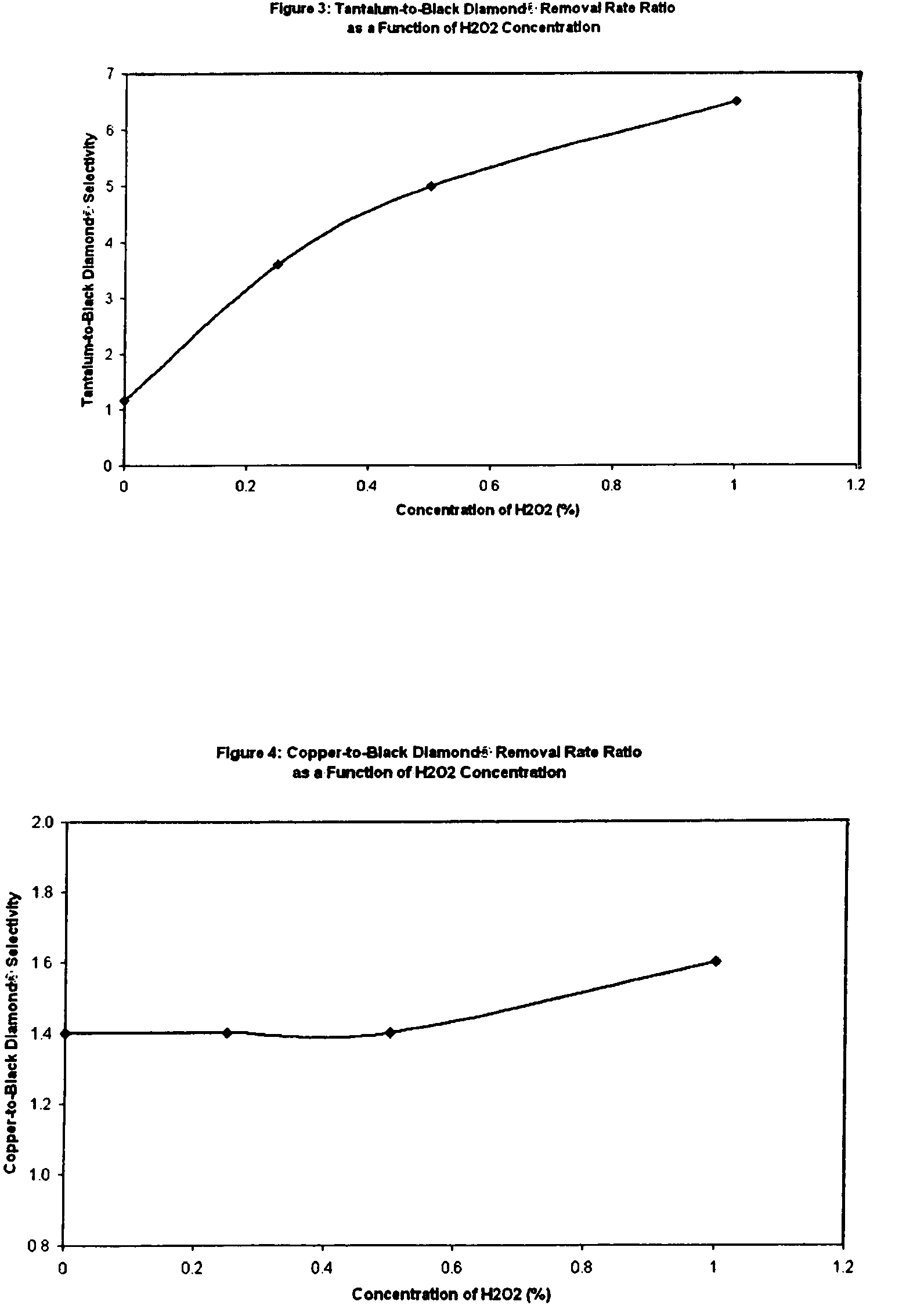[0011]We have surprisingly discovered that non-ionic fluorinated surfactants, of which Zonyl FSN® is a preferred example, when used in a
polishing slurry having a per-type oxidizer, of which
hydrogen peroxide is preferred, provide a mechanism to very effectively tune Black
Diamond® and similar low-k materials such as
CORAL®. Advantageously, use of non-ionic fluorinated surfactants in slurry formulations to tune the removal rate of various low-k materials and especially including Black
Diamond®, depending upon the concentration of the additive, do not significantly affect the removal rates of a
barrier layer (e.g., tantalum), copper, and
oxide (e.g., PETEOS). By not significantly affect the removal rate of copper, we mean the removal rate of copper does not change by over 50% compared to the removal rate in the absence of the non-ionic
fluorosurfactant, or changes by less than 200 Å / min, whichever is lower. By not significantly affecting the removal rate of
barrier layer material, we mean the removal rate of
barrier layer material does not change by over 50% compared to the removal rate of barrier layer material in the absence of the non-ionic
fluorosurfactant, or changes by less than 200 Å / min, whichever is lower. By not significantly affect the removal rate of
oxide, we mean the removal rate of oxide changes by less than 200 Å / min compared to the removal rate of oxide in the absence of the non-ionic
fluorosurfactant. More specifically, the invention includes a method of chemical mechanical
polishing utilizing a slurry comprising a non-ionic
fluorocarbon surfactant and
hydrogen peroxide for controlling the removal rates of certain low-k films (especially carbon-doped oxides) during chemical mechanical planarization of copper. Alternatively, the invention includes a method of chemical mechanical
polishing utilizing a slurry comprising an anionic
phosphate fluorocarbon surfactant and
hydrogen peroxide, alone or in combination with a non-ionic fluorocarbon surfactant, for controlling the removal rates of certain low-k films (especially carbon-doped oxides) during chemical mechanical planarization of copper.
[0015]Advantageously the slurry composition also comprises an aromatic
sulfonic acid, most preferably benzesulfonic acid, in an amount between about 0.05% to 5%, preferably between about 0.2% to 3%, for example between about 0.5% to 1.5% by weight. Aromatic sulfonic acids can have two functions. First, they can act as a second oxidizer and greatly increase barrier
layer removal rates, for example Ta, TaN, Ti,
TiN, and the like, most particularly Ta. Benzesulfonic acid, in the polishing compositions of the current invention, is believed to act synergistically with the
hydrogen peroxide and provide the greatest barrier
layer removal rates if present in an amount between 1% and 1.5% by weight, say about 1.2% or 1.3% in weight. Lesser amounts can be used to reduce (tune) the barrier
layer removal rates. Additionally, aromatic sulfonic acids such as
benzenesulfonic acid are believed to form insoluble precipitates with copper, and thus reduce copper removal rates.
[0023]Preferably, R1O is independently CH2CH2O—, CH2CH2CH2O—, or mixture thereof, more preferably CH2CH2O—. A block of CH2CH2O— segments will form a hydrophilic section “A”, while a block of CH2CH2CH2O— and / or CaH2aO— segments (where “a” is 3 or more) will form a hydrophobic section “B.” One or more of the O atoms can optionally be replaced by a N or S, but preferably more than 70%, more preferably more than 90%, and most preferably all of the bridging atoms are O. It is useful to have blocks of hydrophilic polyoxyethylene where x is at least 4. Preferably the average x is between about 5 to 20, such as between about 8 and about 15. For use on Black Diamond® and
CORAL, preferably R1O is CH2CH2O—. For use on second generation low-k materials having a dielectric constant below about 2.4, blocks of polyoxypropylene advantageously can be included with the blocks of hydrophilic polyoxyethylene to increase the hydrophobicity of the non-ionic fluorosurfactant.
[0024]Further, these fluorinated non-ionic surfactants will be useful for tuning second generation Black Diamond® having a dielectric constant of less than 2.5, more typically less than 2.4, such as about 2.3. For use on Black Diamond® and
CORAL, preferably Rb is H or a straight, branched, or ringed
alkane,
alkene,
alkyne, or
alcohol having between 1 and about 6 carbon atoms. Preferably Rb is H. Because the second generation Black Diamond® is more hydrophobic than Black Diamond®, the inclusion of at least one non-polar segment—e.g., an
alkane moiety having between about 6 and about 18 carbon atoms—should increase the effectiveness of the non-ionic fluorinated surfactant. For use on second generation low-k materials having a dielectric constant below about 2.5, preferably Rb is H or a straight, branched, or ringed
alkane,
alkene,
alkyne,
alcohol, or
fatty acid having between 6 and about 18 carbon atoms. Alternately or additionally, for use on second generation low-k materials having a dielectric constant below about 2.5, preferably (R1O)x includes at least one block of CH2CH2CH2O— and / or CaH2aO— segments.
[0026]Without being bound by theory, we believe the very high effect of very small amounts of the non-ionic fluorinated surfactants of this invention result from an interaction of the non-ionic fluorinated surfactants with the per-type oxidizer to form quasi-stable active free radical species of the non-ionic fluorinated surfactants of this invention are produced as a result of
chemical reaction between the non-ionic fluorinated surfactants and H2O2. By quasi-stable we mean the free radical can exist in solution for an amount of time sufficient for at least some of the free radicals produced to contact the substrate being polished. The quasi-stable non-ionic fluorinated
surfactant free radicals react with and weakly bind to Black Diamond, hence controlling the removal rates of Black Diamond® at very low concentrations.
 Login to View More
Login to View More 


